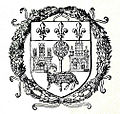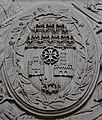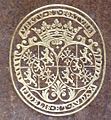Occitan cross

The Occitan cross (also called cross of Occitania, cross of Languedoc, cross of Toulouse;[1] heraldically cross cleché, pommetty and voided) is a heraldic cross, today chiefly used as a symbol of Occitania.
The design was probably first used in the coat of arms of the counts of Forcalquier (in modern Provence), in the 12th century,[citation needed] and by the counts of Toulouse in their capacity as Marquises of Provence, on 13th century coins and seals. It later spread to the other provinces of Occitania, namely Provence, Guyenne, Gascony, Dauphiné, Auvergne and Limousin.
A yellow Occitan cross on a blood-red background with the seven-armed golden star of the Felibritge makes up the flag of modern-day Occitania. It can also be found in the emblems of Midi-Pyrénées, Languedoc-Roussillon and Hautes-Alpes, among many others, as well as in cemeteries and at country crossroads.
The blazon of the modern emblem is gules, a cross cleché (or: pattée) pommettée voided or ("in a red field, a gold cross 'with keys' (or: 'with paws') and 'with spheres/apples', in outline"; Occitan: de golas a la crotz voidada, clechada (or patèa) e pometada d'aur),[citation needed] also described as cross pattée botonnée, cross pommettée, cross toulouse,[2] or cross fleury voided (or: in skeleton).[3] In the Chanson de la Croisade Albigeoise, it goes by the name of "Raymondine cross" (crotz ramondenca).[4]
History


The Occitan cross probably first appears in the coat of arms of the counts of Forcalquier and then during the reign of Raymond V, count of Toulouse, as a particular description of his official seal dated from 1165 corroborates.[citation needed] It soon spreads across the whole south-western part of today's France and is even spotted in various towns up north throughout the 12th century. Several interpretations have been proposed for the cross, often stressing the symbolic side of it and leaving aside the fact that "heraldry is not a science of symbols, but one of emblems" (M. Pastoureau[citation needed]).
In 1950, Henri Rolland suggested that the origin of the Occitan cross be traced back to the marquisate of Provence, north of the Durance, more precisely the town of Venasque.[5]
In 1966, in the L'Auta review, Roger Camboulives voices his idea that the Occitan cross derives from a sun cross and perhaps the Nestorian cross found in China's Turkestan. It would have arrived in Toulouse via northern Italy and Provence, probably sometime in the 10th century. Camboulives in 1980 again emphasizes the role played by the Visigoths in the presence of small spheres at the end of the arms of the cross: they could represent the twelve houses of the zodiac.[citation needed]
In 1986, Jean-Yves Royer (in Le Pays de Forcalquier) claims that the cross was originally from Provence but admits that Henri Rolland's theory was flawed and built around wrong dates. Royer concludes that Rolland possibly mistook the Occitan cross with that of Forcalquier.[citation needed] He draws evidence most notably from two crosses carved in the lid of a sarcophagus found in the small Alpes-de-Haute-Provence commune of Ganagobie.
Pierre Saliès in 1994 [6] once again maintains that the cross is from Toulouse and is the fruit of successive local evolutions, possibly from the Jerusalem cross.
Two years after, in L'Auta (#612), Jean Rocacher confirms that the Occitan cross "is first the own emblem of the old county of Venasque, later torn between the houses of Toulouse and Forcalquier."
In 2000, Laurent Macé (in Les Comtes de Toulouse et leur entourage) claims that the Occitan cross became the counts' emblem after Raymond IV took part in the First Crusade. It would originate from Constantinople. Macé indicates that its pattern was first found in the Byzantine area and spread across Western Europe through Italy and Provence. The crosses of Venasque and Forcalquier would thus share the same origin, though one was not inspired by the other.
Later in the same year, Bertran de la Farge (in La Croix occitane) locates the original Occitan cross somewhere in the marquisate of Provence, probably Venasque. He argues it could be a mixture of the Constantinople cross and the Coptic cross, which was brought to Provence by monks and maybe also through Saint Maurice.
-
15th-century depiction of the arms of Toulouse as a voided cross potent.
-
Late medieval depiction as the coat of arms of the Mozzi family of Florence, in Palazzo Mozzi.
-
Arms of the count of Toulouse (1509)
-
In the Toulouse city arms (1515)
-
Toulouse arms from the time of Henry IV of France (r. 1572–1610)

Modern uses
This article needs additional citations for verification. (June 2018) |

The Occitan cross can be found on a number of flags, coats of arms, emblems and logos. Here follows a non-exhaustive list of occurrences:
Regions and provinces
- Flag of Languedoc-Roussillon
- Flag and emblem of Midi-Pyrénées
- Flag of the Aran Valley
Départements
- Coat of arms of Aude and the General Council of Aude
- Coat of arms of Gard
- Coat of arms of Hautes-Alpes
- Coat of arms of Haute-Garonne
- Coat of arms of Hérault
- Coat of arms of Tarn
- Coat of arms of Tarn-et-Garonne
Cities and towns

- Coat of arms of Ansignan
- Coat of arms of Buoux[7]
- Coat of arms of Céreste
- Coat of arms of Colomiers
- Coat of arms of Fanjeaux
- Coat of arms of Gigondas[8]
- Coat of arms of Laissac
- Coat of arms of Llupia
- Coat of arms of Méthamis[9]
- Coat of arms of Moissac
- Coat of arms of Monclar (impaled)[clarification needed]
- Coat of arms of Port-la-Nouvelle
- Coat of arms of Saint-Didier
- Coat of arms of Sévérac-le-Château
- Coat of arms of the City of Toulouse
- Coat of arms of Travaillan[10]
- Coat of arms of Venasque[11]
- Flag of Vianne[12]
- Coat of arms of Villeneuve-d'Aveyron
- Coat of arms of Villefranche-de-Lauragais
- Coat of arms of Villefranche-de-Rouergue
Miscellaneous
- Logo of Toulouse FC
- Place du Capitole, Toulouse[13] 43°36′16″N 1°26′36″E / 43.604389°N 1.443361°E)
- Coat of arms of La Tour d'Auvergne
- Street signs in Toulouse
- Roadsigns in Limousin[14]
- Sign of the Conseil Interprofessionnel des Vins du Languedoc[15]
See also
References
- ^ After the coat of arms of the counts of Toulouse. "The first known Cross of Toulouse is shown on Count Raimond VI's seal, dated from 1211. Then widely used all over Languedoc, the Cross of Toulouse appeared on the municipal arms of Toulouse and the provincial arms of Languedoc in the 14th century. Pierre Saliès (Archistra, December 1994) claims that the Cross of Toulouse is a modification of the Latin Cross, attributed to Count Raimond VI. In 1099, Raimond VI took part to the reconquest of Jerusalem with the Crusaders. As a Crusaders' chief, Raimond would have adapted a cross slightly different from the Latin Cross bore by the low-rank Crusaders. According to this theory, the edges of the arms of the cross were cut into two pieces and curved. To be fixed on a shield, such a cross required twelve rivets. The design would have progressively evolved towards the Cross of Toulouse." (Ivan Sache, 24 April 2003, crwflags.com)
- ^ Thomas Robson, The British Herald (1830), p. 336.
- ^ Catherine Lucy Wilhelmina Powlett Duchess of Cleveland, The Battle Abbey Roll vol. 3 (1889), p. 182.
- ^ La Cançon de la crosada, laisse 109 (v. 2300), Per la crotz Ramondenca que contral vent resplant, see L. Macé in: Marcus Graham Bull, Catherine Léglu (eds.), The World of Eleanor of Aquitaine: Literature and Society in Southern France Between the Eleventh and Thirteenth Centuries (2005), p. 152.
- ^ "Toulouse (Municipality, Haute-Garonne, France)". crwflags.com.[failed verification]
- ^ Archistra magazine,[clarification needed] December 1994
- ^ "Archived copy". Archived from the original on 2007-10-18. Retrieved 2007-08-11.
{{cite web}}: CS1 maint: archived copy as title (link) - ^ "Archived copy". Archived from the original on 2011-07-21. Retrieved 2007-08-11.
{{cite web}}: CS1 maint: archived copy as title (link) - ^ "Archived copy". Archived from the original on 2007-10-19. Retrieved 2007-08-11.
{{cite web}}: CS1 maint: archived copy as title (link) - ^ "Data" (GIF). vexil.prov.free.fr.
- ^ "Data". www.vaucluse.fr. Archived from the original (GIF) on 2007-03-07.
- ^ "Data" (GIF). www.crwflags.com.
- ^ "Archived copy". Archived from the original on 2007-09-27. Retrieved 2007-05-30.
{{cite web}}: CS1 maint: archived copy as title (link) - ^ "Archived copy". Archived from the original on 2008-11-12. Retrieved 2007-06-09.
{{cite web}}: CS1 maint: archived copy as title (link) - ^ "L'AOC Languedoc fête ses 30 ans !". languedoc-wines.com. Retrieved 31 December 2016.
- Les Comtes de Toulouse et leur entourage: Rivalités, alliances et jeux de pouvoir XIIe-XIIIe siècles by Laurent Macé (éd. Privat)[year needed]
- La Croix occitane by Bertran de la Farge (éd. Loubatières)[year needed]
- Le Pays de Forcalquier by Jean-Yves Royer (éd. Équinoxe)[year needed]
External links
![]() Media related to Occitan cross at Wikimedia Commons
Media related to Occitan cross at Wikimedia Commons







